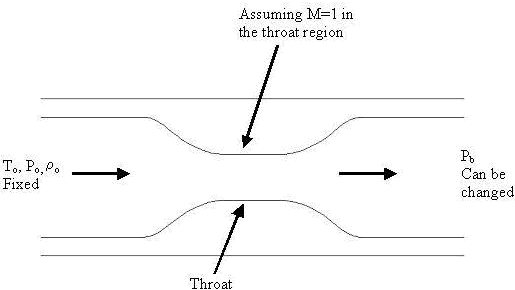In any flow the conservation equations much be satisfied. In the case of having a choked flow I will be paying particular attention to the mass conservation equation:
![]()
![]()
![]()
![]()
![]()
![]()
Now in the case of a choked flow where M =1, in this case at the
throat, the mass flow rate through the throat is constant. That is,
once the reaches its threshold of M=1, no matter what changes take
place upstream and downstream of the flow the mass flow rate will
remain the same. The question is now how does the flow speed up? The
answer to that goes back to mass conservation. In the previous
equations I showed you that the density of a gas is inversely
proportional to the velocity, ![]() . If you look
closer at the conservation of momentum equation, you will also get
another equation in terms of velocity and pressure,
. If you look
closer at the conservation of momentum equation, you will also get
another equation in terms of velocity and pressure,
![]()
In an accelerating isentropic flow, the pressure and density decrease while the velocity increases. The reason why changes in the back pressure pb of the flow have no effect on the flow once M=1 is reached is because all pressure changes in the flow propagate in the nozzle at the speed of sound. Once the gas velocity reaches the speed of sound, M=1 at the throat, the effects of the changes cannot propagate up the nozzle since all the changes in the flow are traveling at the speed of sound (the same speed as the flow itself). Therefore once M=1 is reached at the throat; changes in the back pressure will not influence the flow in the nozzle and therefore cannot influence the mass flow rate through the nozzle. A converging-diverging nozzle is illustrated in figure 1 below.

Instructor's Note: This was written by graduate student Charney Davy. The physical explanation why the flow no longer increases when the Mach number in the throat reaches unity is correct, though the relationship with the provided formulae, for a constant area duct, could have been made more clear.